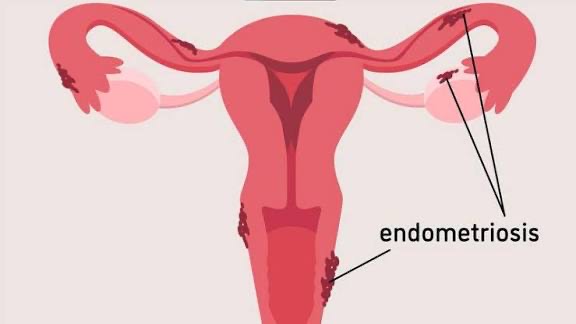Many women experience pain during their monthly period. But when the pain begins days before menstruation, continues after it ends, and becomes so severe that it affects normal activities, it may not be ordinary cramps.
Health experts say this kind of pain could be a sign of endometriosis.
Misconceptions and delayed diagnosis
Speaking with PT Health Watch, Qudus Lawal, a Consultant Obstetrician and Gynaecologist (Oncology) at Irrua Specialist Teaching Hospital, Edo State explained why endometriosis is so often overlooked in Nigeria.
Mr Lawal said many people still believe all menstrual pain is normal. While mild cramps are common, he noted that sudden or unusually severe pain, particularly when accompanied by symptoms such as painful intercourse or abdominal swelling, should raise concern.
One of the biggest challenges, he explained, is that it can take up to 12 years from the onset of symptoms before endometriosis is properly diagnosed. By that time, significant damage may already have occurred, limiting treatment options.
Even when endometriosis is suspected, he said, diagnosis can be difficult because the required procedures are not widely available in lower-level health facilities.
Endometriosis
According to the Mayo Clinic, endometriosis is a painful condition in which tissue similar to the lining of the uterus grows outside the womb.
This misplaced tissue often appears on the ovaries, fallopian tubes and the lining of the pelvis. In rare cases, it can spread to areas beyond the pelvic organs.
Endometriosis tissue behaves much like the normal lining of the uterus, it thickens, breaks down and bleeds with each menstrual cycle.
The difference is that this tissue grows in places where it does not belong, and the blood has no way of leaving the body.
When endometriosis affects the ovaries, it can lead to Ovarian endometriomas, according to Cleveland Clinic.
These are fluid-filled sacs, often containing old blood, sometimes called “chocolate cysts.”
They can cause severe pain and, in some cases, affect fertility.
The condition may also irritate surrounding tissue, leading to scar tissue. In some women, bands of fibrous tissue called adhesions form, causing pelvic organs and tissues to stick together.
These complications often add to the pain and make the condition more difficult to live with.
The size of endometriomas can differ greatly. Some remain small and unnoticed for a while, while others grow large enough to affect one or both ovaries, leading to more severe symptoms.
Unlike ordinary menstrual cramps, the pain linked to endometriomas can occur at any time of the month, not just during periods.
Women may also experience very painful menstruation, discomfort during sexual intercourse, or pain when urinating and passing stool.
In some cases, symptoms extend beyond the pelvis, with frequent urges to urinate, persistent back pain, bloating, nausea or even vomiting.
Can Endometriosis Be Prevented?
Although the World Health Organisation (WHO) notes that there is no known way to prevent endometriosis, greater awareness and early diagnosis can help slow its progression and reduce long-term complications.
Mr Lawal noted that treatment, however, is possible both medically and surgically.
He explained that doctors usually tailor care to each woman’s most pressing symptoms. For some, treatment is focused on improving fertility, while for others, the priority is pain management.
Medical approaches often begin with hormonal therapy to suppress the activity of endometrial tissue, though this may sometimes affect a woman’s ability to conceive. Surgical procedures are also used in more advanced cases to remove affected tissue.
He stressed that treatment is usually graded, beginning with the simplest options and only moving to more complex interventions if necessary. Many women respond well to basic medical therapy, but access to such care remains a challenge in Nigeria.
Mr Lawal emphasised that making treatment affordable and widely available should be a priority for the government, as reducing costs would go a long way in helping women live without the constant burden of endometriosis.
Awareness Matters
Beyond the medical and surgical options, Mr Lawal underlined that ignorance about endometriosis is one of the greatest barriers to proper treatment.
Many women do not know the condition exists, and as a result, they often delay seeking help until symptoms become severe. By that point, he noted, the disease may already have advanced, making it harder to treat with simple methods.
He also pointed out that this lack of awareness is not limited to patients. General healthcare providers, such as nurses and general physicians, often have a low index of suspicion for endometriosis.
He stressed the need for Nigeria to scale up awareness programmes.
Specialists are already leading campaigns, but he said this must extend to general health workers, who are often the first point of contact, and to the wider public so women understand that severe or unusual menstrual pain should not be endured in silence.
READ ALSO: PT Health Watch: What to know about postpartum haemorrhage, leading cause of maternal deaths
“There is an annual awareness programme that’s trying to increase awareness about endometriosis. And the Nigerian Society for Endocrinology and Gynaecological Endocrinology are constantly raising that awareness”.
“There is also a need to increase awareness amongst general health practitioners,so that you can have a high index of those patients.
It is also important to raise awareness to the general population that menstrual pain is not normal, especially when it is not primary,” he said.










